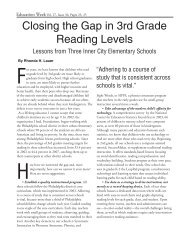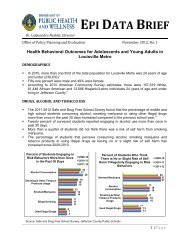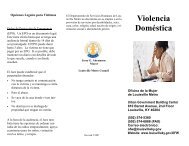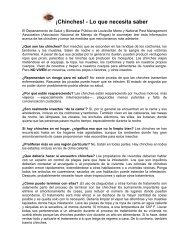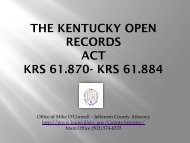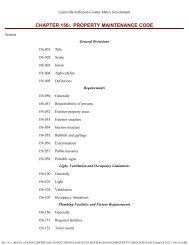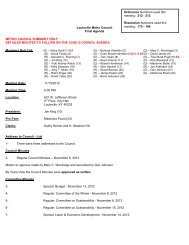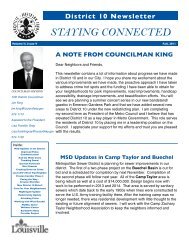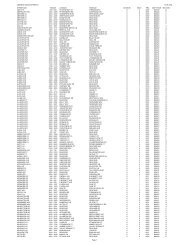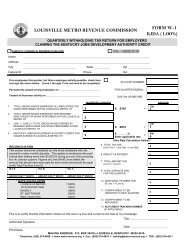Cultural History of Charlie Vettiner Park - Louisville Metro Government
Cultural History of Charlie Vettiner Park - Louisville Metro Government
Cultural History of Charlie Vettiner Park - Louisville Metro Government
Create successful ePaper yourself
Turn your PDF publications into a flip-book with our unique Google optimized e-Paper software.
<strong>Cultural</strong> <strong>History</strong> <strong>of</strong> <strong>Charlie</strong> <strong>Vettiner</strong> <strong>Park</strong><br />
Richard Chenoweth is another early settler who had a great amount <strong>of</strong> influence on the early<br />
development <strong>of</strong> <strong>Louisville</strong> and the outlying area around Jeffersontown. According to records <strong>of</strong><br />
The Church <strong>of</strong> Jesus Christ <strong>of</strong> Latter-day Saints, Richard Chenoweth was born in 1734 at<br />
Chenowith Manor in Baltimore County, Maryland. Some records suggest his heritage traces<br />
back to Charles Calvert, the 3 rd Lord Baltimore. He had served as a captain under George<br />
Rogers Clark and also served as a sheriff; he was with Clark when the first settlement at Corn<br />
Island was established in 1778 (Pirtle 1909). Chenoweth was instrumental in finishing the<br />
building <strong>of</strong> the second, larger Fort Nelson in <strong>Louisville</strong> in 1782 (Hammon 1978; Jobson 1977).<br />
Chenoweth claimed 2000 ac along a tributary <strong>of</strong> Floyd‘s Fork, but his claim overlapped with that<br />
<strong>of</strong> Col. William Fleming. Fleming won the land, but Chenoweth‘s name became associated with<br />
the waterway. In 1771, Chenoweth married Margaret (Peggy) McCarthy in Jefferson County,<br />
Kentucky. All <strong>of</strong> their children were born there; they included the following:<br />
Gideon (b. 1772)<br />
Mildred (~1774-1835)<br />
Jane, (b.~1776)<br />
Levi (~1779-1789)<br />
Naomi (b.~1780)<br />
Margaret (~1781-1781)<br />
Tabitha (b.~1783)<br />
Mary (b.~1785)<br />
Ann (b.~1792)<br />
Thomas (b. 1775)<br />
James P. (1777-1852)<br />
The Chenoweth family‘s experience has been highlighted <strong>of</strong>ten as an exemplary early frontier<br />
experience in Kentucky—exemplary as in an example <strong>of</strong> the tragedy that frontier life in Kentucky<br />
could entail. Although much <strong>of</strong> Kentucky had been settled by American settlers, Native<br />
American groups to the north and west continued to harass the stations and cabin sites<br />
surrounding <strong>Louisville</strong>. The year 1789 saw a number <strong>of</strong> forays into the Pond Settlements from<br />
Indiana around the Salt River drainage (Pirtle 1909). Other forays came from the east, including<br />
one to Chenoweth‘s station east <strong>of</strong> Middletown. Here, the family and six militiamen holed up in<br />
the stone springhouse. Native forces, however, overtook the structure. One son, two daughters,<br />
and two militiamen were killed. Richard was wounded, and Peggy was tomahawked and<br />
scalped (Hammon 1978:165). Richard lived until 1803; Peggy lived until 1825.<br />
A number <strong>of</strong> other settlers were influential in the development <strong>of</strong> the Jeffersontown area. William<br />
Goose Sr. arrived in Jeffersontown around 1790 from Pennsylvania. Originally, his name is<br />
believed to have been Wilhelm Gantz (Johnston 1997; Greater Jeffersontown Historical Society<br />
2008); plausible genealogical lines trace back to York, Pennsylvania and then to Germany. In<br />
Jeffersontown, William found employment as a wheelwright, wagon maker, and furniture maker.<br />
His property included a home on the northwest corner <strong>of</strong> Watterson Trail and College Drive;<br />
additional lands lay near Rehl Road and Blankenbaker Lane (Johnston 1997). The large<br />
Blankenbaker (Blankenbeker) family also came into the area at about the same time.<br />
The Hoke family appeared on the scene from York, Pennsylvania around 1795. Members<br />
included Revolutionary War veteran Andrew Hoke and sons Jacob Hoke (1771-1843) and<br />
Adam Hoke. Andrew purchased Colonel Frederick Geiger‘s 400-acre property and constructed<br />
a stone house in 1799. Andrew Hoke was influential in the formation and development <strong>of</strong> the<br />
German Reformed Presbyterian Church. According to LDS records, the Hoke family came from<br />
24 | P a g e



